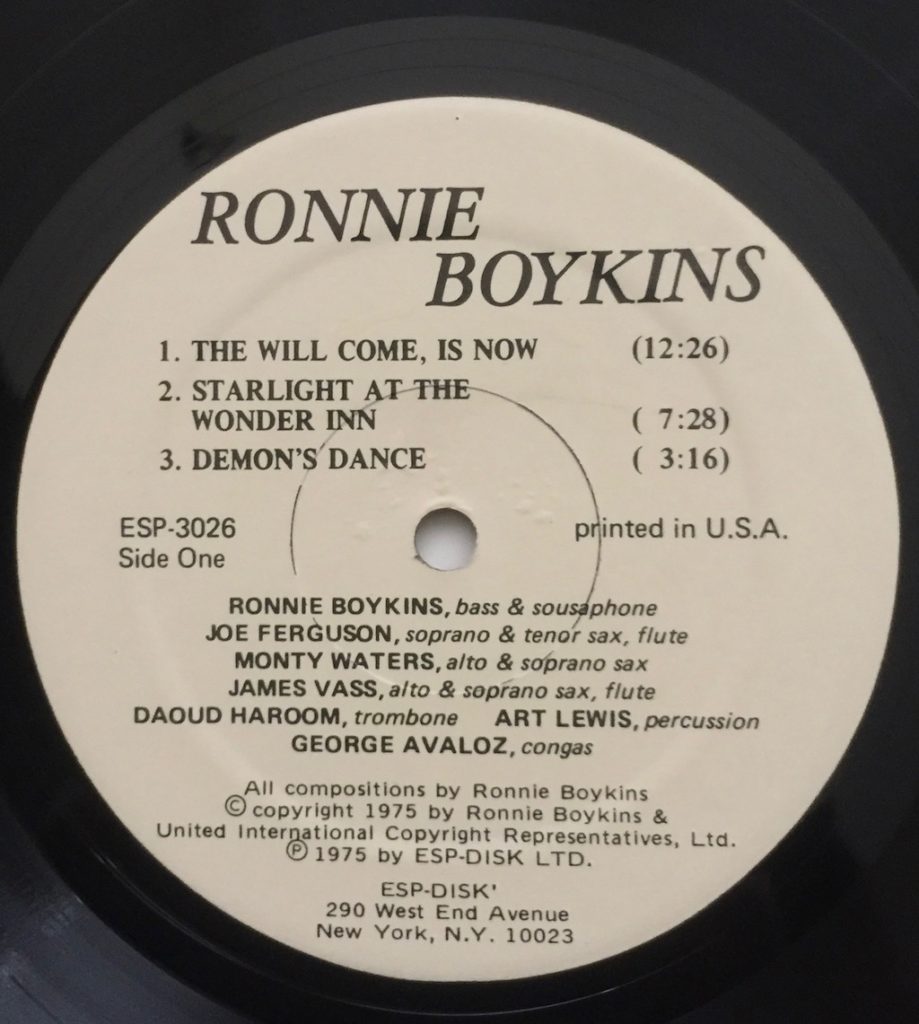Ronnie Boykins (The Will Come, Is Now)

Ronnie Boykins was a disciple of Sun Ra’s Arkestra with a long list of credits as a bassist. This album, which is Boykins’ sole release as a band leader, is great fun. It starts with “The Will Come, Is Now,” a good simple bass line that is joined by an agglomeration of horns that sound, well, a little “off”—maybe somewhat out of tune, a little discordant, it could be just a free jazz thing where everybody is playing something different, but I find it amusing. They knock it into shape as they get going, though, and it gets better as the instruments cohere.

The horns transition beautifully from alto to soprano to tenor and what sounds like discord now begins to make more sense. The drums are crisp snare and deep kick drum; the trombone (a neglected instrument) is beautifully set against the percussion and that relentless bass line. The sonics on this album are extremely good in the sense that the instruments sound very real- listen to the bowed bass against the various percussion bits in that section of the first track—stark and uncluttered and you get a real sense of the original recording space. When the band comes back in, and reprises the original theme, you are now fully accustomed to this sound and probably wouldn’t have it any other way—they sneak some gorgeous harmonies into the off-center playing, enough to know it’s deliberate.
“Starlight at the Wonder Inn” is far more “normal” sounding, with a warm bowed bass and very controlled horns playing something that is melodic and extremely accessible. This track, alone, is worth the cost of the album- demo level material that could compete with the best of the cherished “audiophile” stuff. If you love the sound of double bass, in the hands of a consummate player, you’ll love this track. When the horns come back in, the bass still defines the melodic line—it’s almost traditional but performed with an edge and the depth and harmonics of the instrument are on full display.
The first side finishes with a bit of cacophony entitled “Demon’s Dance”, described in the liner notes as “[e]nsemble solos.” The band comes together at the end in unison.

The “B” side also contains three tracks. The first, “Dawn is Evening, Afternoon” starts with a slow horn ensemble drawing you in when the soloing begins—competing saxes that meet and swing away into their own excursions. Boykins keeps it together on the bass and Art Lewis, on percussion, is masterful here. We return to what sounds like a funereal lament-for some reason the bass isn’t as pronounced in the mix at the end, which is a truly minor quibble.
“Tipping on Heels” has a jazzy horn orchestra that sounds like it is playing in a big room.
The album finishes with “The Third I,” which as you might gather, is a little “out there”—various noise makers on intro with some horn blats, various explorations of percussion, horn inventions, a nice bit on flute.

The copy reviewed here is an original pressing from 1975 on ESP-Disk. That label had some fascinating releases, most of them of the avant-garde variety—free jazz, The Fugs, a mix of underground, a lot of notable players and some historic live releases. There are a number of articles on the web about the label and Bernard Stollman, its founder, as well as “best of” lists that are probably worth a read. The label is still active, though Stollman has passed away.
In the meantime, this record, which sounds fabulous and has some tracks that are truly enjoyable, is more than just a collector’s piece or a musical oddity. Well worth finding a clean playing copy if you are going to bother.
Bill Hart
Austin, TX
September, 2019
Leave a Reply
You must be logged in to post a comment.